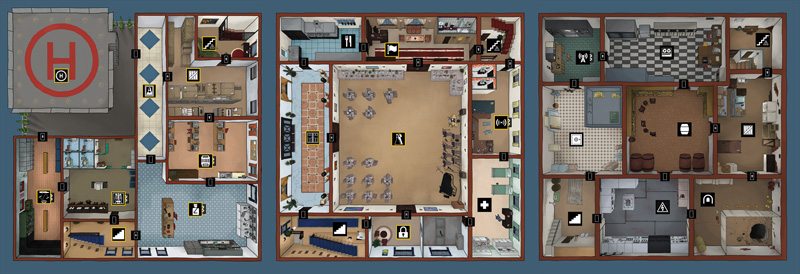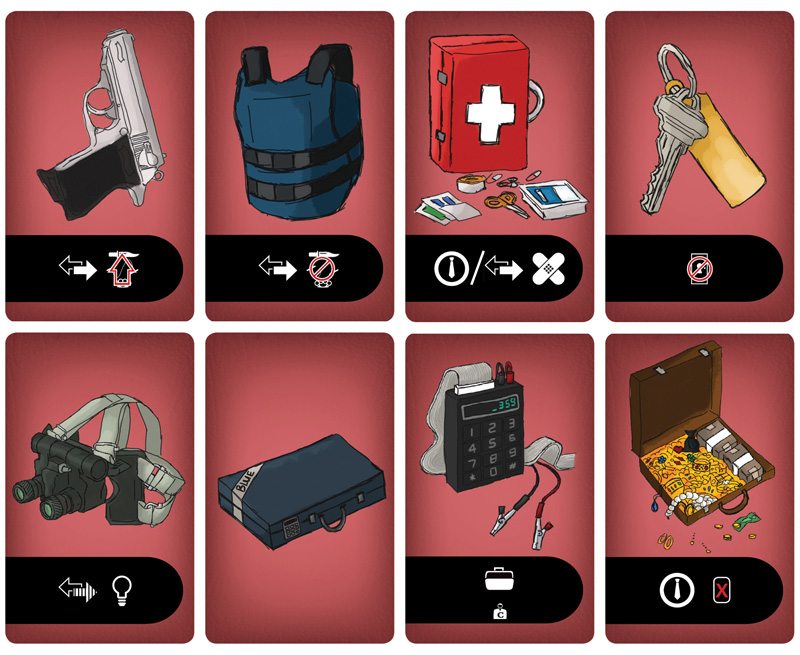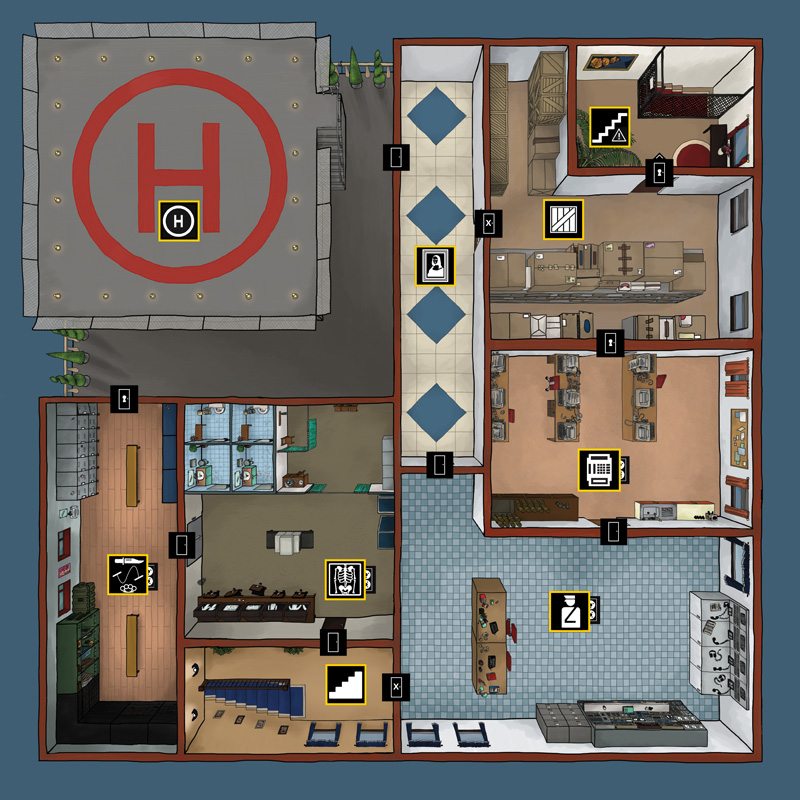Trust no one. That’s the first lesson you learn about [redacted], a game of spycraft and intrigue. Acquire the right file and make your getaway—but watch out for the other team … if you can figure out who they are.
At a glance: [redacted] is a game for 2 to 6 players, ages 12 and up, and takes about 45 minutes to play. The game is currently seeking funding on Kickstarter, with a basic pledge level of $55 for the game. The tactics for outsmarting your opponents can be a little tricky, but the game mechanics are fairly straightforward, so more experienced kids may be able to pick it up—but otherwise probably 12 and up is about right.

Components
- 3 Game Boards
- 11 wooden meeples:
- 6 spies (red, green, blue, yellow, white, purple)
- 4 guards (black)
- 1 VIP (grey)
- 17 wooden discs:
- 1 reception
- 1 lock
- 1 light
- 13 points
- 1 jamming
- 93 Cards:
- 33 Item cards
- 49 Interaction cards
- 8 Alert cards
- 3 Guard Weapon cards
Some of the components are only used in specific game modes.
The game board shows three floors of the embassy—the ground floor, basement, and second floor (including rooftop helipad), and there are lots of little details in the illustrations. Each room has an icon identifying it, and some rooms have special functions based on which game mode you’re using. The doorways between rooms are also marked as normal doors, X-ray doors, or locked doors.
![[redacted] Loyalty cards](https://149455152.v2.pressablecdn.com/wp-content/uploads/2014/08/redacted-identities.jpg)
How to play
There are various modes of play available, depending on the number of players and the type of experience you’d like, but there are some essential rules that stay the same throughout.
I’ll start by explaining the standard game which works for 4 players–it’s the mode recommended to start with. The goal of the game is to acquire the enemy’s secret file and fly away in your helicopter. Or, failing that, blow up both of your enemy’s helicopters.

To set up, everyone starts in the entrance hall. Each player also gets one loyalty card (there will be two players in each faction), and a hand of five cards: Friendly, Neutral, and three Weapons. The Weapon cards have a sort of rock-paper-scissors mechanic—brass knuckles beat the knife, knife beats the garotte, garotte beats the brass knuckles. You also start with one Item card. The four helicopters (2 Russian, 2 British) are placed in the helicopters area (not on the helipad).

On your turn, you may walk through as many doors as you like and go up and down stairs, as long as you do not pass through a space occupied by another player. (Locked doors, however, require a key to unlock.) You must leave the room you are in except when using particular items: intel, Bombs, First Aid Kits, and Contraband. Then you may use the action of the room where you stop, if any. Here are some examples of room actions:
- Radio room: call a helicopter to the helipad if it’s not already occupied
- Stock room: draw an item card (hand limit 3)
- Ballroom: recall all players to the ballroom (only once per game)
- Breaker room: turn lights off or back on
- Armory: get more weapon cards
- Helipad: fly away in a helicopter (or bomb a helicopter)
![[redacted] Interaction cards](https://149455152.v2.pressablecdn.com/wp-content/uploads/2014/08/redacted-interactions.jpg)
- Friendly vs. Friendly: players may swap items
- Friendly vs. Neutral: Friendly player may give Neutral player an item
- Neutral vs. Neutral: nothing happens
- Attack vs. Neutral or Friendly: Attack wins
- Attack vs. Attack: the dominant weapon wins.
Used weapons (win or lose) are discarded face-down to the player’s personal discard pile. Once all of your weapons have been used, you return them all to your hand. Friendly and Neutral cards are always returned to your hand.
If you win an interaction, you take a reward from the other player: you may injure them, steal an item, or interrogate them. Injured players may only move two rooms at a time. The interrogation has a pretty interesting resolution, though: the losing player takes their Neutral card, their Friendly card, and their loyalty card, and mixes them up face-down. The winning player takes one of them, looks at it, and then puts it back, mixing up the cards again before returning them. In this way, you’re never guaranteed to find out somebody’s identity, but they also have no way of telling whether you’ve actually figured them out or not.
The winning player may choose to boot the losing player into an adjacent room (they’re sneaking out). Or if the winning player is the active player, they may sneak themselves out to an adjacent room instead. If a sneaking player enters a room with another player, that other player may choose to let them pass, or knock them out, and take a free reward from them. Knocked out players are effectively invisible until their next turn, when they wake up.
To win the game, you must find the enemy’s file (which will either be in a storage room or in somebody’s hand), call your helicopter, and get to the helipad. (Or blow up both enemy helicopters to prevent them from getting away.)

There are a lot of items that can be found in the stock rooms (or stolen from other players). Guns and bulletproof vests can be used during an interaction that involves weapons to better your position or prevent yourself from losing. First aid kits heal you, keys let you through locked doors, and night vision goggles let you see other spies even when the lights are off. Each briefcase actually holds another card (which is stored on the board). If you have the code-cracker, you may then look at the contents of a briefcase and optionally swap it with something else. Finally, the suitcase of contraband is an item that basically takes up space in your hand and cannot simply be discarded; however, you may spend your movement action to “stash” the contraband, which lets you stay in the same room and potentially use its action again.
There are other modes of play as well: The Intro game is another 4-player mode which reduces the number of rooms that have actions, to simplify the game and focus on the double-blind bluffing. For 5 players, you can add the Interpol agent, who can attempt an arrest—the spies with a bloodspot on their loyalty cards are wanted criminals, and if the Interpol agent arrests them, they’re out of the game. There’s also a 3-player advanced version that’s a 2-vs-1 game, but you have to work to figure out which two factions are supposed to be working together. The 2-player mode gives you various objectives to complete, from escorting the VIP to a particular hideout to decrypting codes to uploading data. This variant also features guards that will show up as the agents arouse suspicion.
I was only able to play the 4-player “Classic” mode, which I described above.

The Verdict
As with LudiCreations’ last Kickstarter campaign (for ESSEN), I was able to try the game using the Vassal game engine. It’s certainly more convenient than making up a bunch of prototypes and shipping them around the world, but it does mean losing the face-to-face interaction. (We had a Skype call going simultaneously for audio.) And in a game like [redacted], I think you really do need to be able to see the other players’ faces.
Even so, I can see that [redacted] has a lot of potential, and I enjoyed playing it even though I was clearly very bad at the rock-paper-scissors weapons. I think the classic mode would be enough to keep me coming back, but I’m also curious about the other modes of play, too.
Speaking of the weapons—the first time in a game two players use weapons, it really is like rock-paper-scissors, because you have one of each type. But then the weapon you used is discarded, and you don’t get it back until all of your weapons have been used once. So each time you use a weapon, your position gets weaker, particularly if your opponents know which weapons you lack. You can always ask other players what weapons various players have used … but you don’t know whether to trust their answers. You can, of course, get more weapons cards by going to the Armory, but that takes time and actions… during which your opponents may be getting away with your file!

One of the things that really makes the game fascinating is the double-blind nature of the interactions. If two other players have an interaction, all you know is who won and whether they played weapons—but since the weapons are discarded face-down, you don’t know which weapons. Even after you get interrogated, you’re never absolutely sure whether the other player actually saw your loyalty card or not—and then they can lie to other players about you. Or maybe they’re telling the truth. Who can you trust? If a player blows up one British helicopter, is it because they’re Russian? Or because they’re trying to throw you off their trail? This makes for some really interesting gameplay, and I’m eager to play it more.
All in all, [redacted] is a fascinating spy game—if you love hidden roles and secret missions, you should take a closer look.
For more about [redacted], visit the Kickstarter page.

![[redacted] cover](https://149455152.v2.pressablecdn.com/wp-content/uploads/2014/08/Redacted-cover.jpg)



